The recommendation of the national commission for minority educational institutions to establish a Central Madarsa Board to standardise the disparate and often arbitrary syllabuses of the country’s 30,000 madarsa schools, has aroused the opposition of orthodox Muslim clergy. Puja Awasthi reports from Lucknow
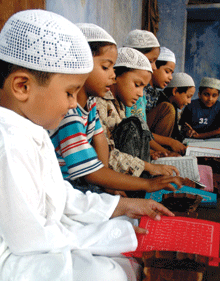 There is a growing sense of unease in the ranks of Indian liberals and Muslim intellectuals across the country, that the much debated subject of reforming India’s Muslim minority schools which provide — or are supposed to provide primary and secondary education to an estimated 1.1 million children of the country’s 150 million strong Muslim population — is disappearing off the national radar screen.
There is a growing sense of unease in the ranks of Indian liberals and Muslim intellectuals across the country, that the much debated subject of reforming India’s Muslim minority schools which provide — or are supposed to provide primary and secondary education to an estimated 1.1 million children of the country’s 150 million strong Muslim population — is disappearing off the national radar screen.
According to a front page news report in the Kolkata-based daily Telegraph (June 27), the prime minister’s office (PMO) has sent a stinging raspberry to the Union human resource development ministry accusing it of “repeatedly delaying” recommendations of a high-level committee to modernise madarsa school education. Over a year ago a three-member committee headed by Justice (Retd) M.S.A. Siddiqui had submitted a detailed proposal for liberal provision of secular mainstream (English, science, maths, computer science etc) education in Muslim madarsa schools, which provide religious and variable secular education to over 1 million children of the minority community. With a general election looming on the horizon, there is a new, even if belated urgency to introduce mainstream or vocationally oriented education for children of the country’s Muslim minority, which is a massive vote bank.
Indisputably, India’s Muslim minority, which ruled the subcontinent for three centuries during which it assimilated with the indigenous population and greatly enriched Indian culture and performing arts, needs all the help it can get to raise itself up to become full, contributing citizens of secular India. The pathetic socio-economic condition to which the Muslim community — barring a thin upper crust — has been reduced, was recently highlighted by a report of the Prime Minister’s High Level Committee on Social, Economic and Educational Status of the Muslim Community of India (more popularly known as the Sachar Committee after its chairman Justice (Retd) Rajinder Sachar), submitted in November 2006. The first comprehensive study of its kind, it details just how poorly Muslims are situationed in comparison with the majority community and other religious and social minorities.
According to the Sachar Committee’s report, only 59.1 percent of the country’s Muslim population is literate, significantly lower than the national average of 65.1 percent; against a mean of four years of schooling, Muslim children complete only three years and four months in school; one of every four (25 percent) Muslim children has never attended school; at the tertiary level, only one of 25 undergraduate and one of every 50 postgraduate students is Muslim, and only 6.3 and 6.8 percent of the country’s Muslim citizens are graduates and diploma holders — a statistic which compares unfavourably against the historically deprived and discriminated scheduled castes and scheduled tribes languishing at the very base of the Hindu caste hierarchy.
This education deprivation is reflected in the employment profile of the community. Despite Muslims constituting 15 percent of the national population, only 3 percent, 1.8 percent and 4 percent of the officer cadre of the Indian Administrative, Indian Foreign and Indian Police Service is Muslim, and the community’s representation in Indian Railways (4.5 percent), police constabulary (6 percent), public health (4.4 percent) and transport services (6.5 percent) is equally disproportionate. (see box p.70).
Against this backdrop of under-representation in public governance institutions, in April 2007 the National Commission for Minority Educational Institutions (NCMEI) recommended establishment of a Central Madarsa Board (CMB) to standardise the disparate and often arbitrary syllabuses being taught in the country’s estimated 30,000 madarsa (aka madrassa) schools countrywide. Although popularly believed to be purely religious institutions offering hifz (memorisation of the Quran), most madarsas also teach science, maths, civics, philosophy etc. However in the great majority of madarsas the lingua franca is Arabic, and science subjects are tinged, if not infused, with religion (‘Islamic science’).
Yet perhaps the great drawback of the madarsa school system is lack of standardisation. The best among the country’s 10,700 government recognised madarsas are affiliated with state-specific madarsa boards, with curriculums broadly similar to state examination board schools in addition to religious instruction. But the great majority offer arbitrarily, even haphazardly, formulated curriculums which include literal translations of ancient scriptural texts and commentaries. The need to standardise madarsa education and enrich its secular content — while respecting the importance of learning Quranic scriptures within it — is the stimulus behind the proposal to establish the Central Madarsa Board modeled on the Union HRD ministry administered Central Board of Secondary Education (CBSE) — the country’s largest pan-India secondary school examination board with 9,688 schools affiliated with it.
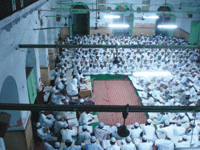 Unsurprisingly NCMEI’s call for the “emergence of a Muslim vox populi unmediated by clerics” has met with opposition from the orthodox Muslim clergy and madarsa teachers. Soon after the CMB proposal was floated by the commission, 3,500 madarsa delegates converged at the Darul Uloom in Deoband on May 13/14 and passed a resolution opposing the initiative. Even though repeated e-mails sent by your correspondent requesting an interview with the Darul Uloom vice-chancellor Maulana Marhboobut Rahman failed to elicit response, his reaction to the proposal is well documented in numerous media reports. Rahman has described the proposal as “a dangerous poison that aims at killing the system of madarsas”. “If we are not able to comprehend the gravity of the matter and reach a timely decision, the coming time shall never forgive us. Madarsas were founded to impart the education of Quran, Hadith and other Islamic Sciences, to preserve the Islamic legacy and culture… the global powers are afraid of madarsas’ heroic role; and therefore they are conspiring to derail them from the right track,” he told clerics at the two-day convention of May 13-14.
Unsurprisingly NCMEI’s call for the “emergence of a Muslim vox populi unmediated by clerics” has met with opposition from the orthodox Muslim clergy and madarsa teachers. Soon after the CMB proposal was floated by the commission, 3,500 madarsa delegates converged at the Darul Uloom in Deoband on May 13/14 and passed a resolution opposing the initiative. Even though repeated e-mails sent by your correspondent requesting an interview with the Darul Uloom vice-chancellor Maulana Marhboobut Rahman failed to elicit response, his reaction to the proposal is well documented in numerous media reports. Rahman has described the proposal as “a dangerous poison that aims at killing the system of madarsas”. “If we are not able to comprehend the gravity of the matter and reach a timely decision, the coming time shall never forgive us. Madarsas were founded to impart the education of Quran, Hadith and other Islamic Sciences, to preserve the Islamic legacy and culture… the global powers are afraid of madarsas’ heroic role; and therefore they are conspiring to derail them from the right track,” he told clerics at the two-day convention of May 13-14.
However, because of post- independence India’s secular traditions — imperfect as they are — this country’s Muslim intelligentsia is not cowed by the clergy and ulemas as are its counterparts in the Middle East kingdoms and satrapies. For instance Shaista Ambar, the Lucknow-based co-founder and chairperson of the All India Muslim Women Personal Law Board (estb. 2006) is forthright in condemning the clergy for its failure to encourage secular education of Muslim children and youth and improve the depressing socio-economic profile of the community.
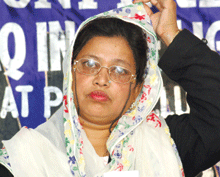 “India’s hardworking Muslim minority has been badly let down by the ulemas (clerics) and shameless politicians. Both have a vested interest in perpetuating the community’s backwardness. Consequently the Muslim community is neither socially respected nor politically empowered. Political leaders like to retain Muslim youth as ignorant vote banks and the ulemas are complicit with them. There is no seriousness within community leaders about discussing policy issues that will set our youth on the path of development. Much time is expended on issues such as Aligarh Muslim University’s minority status and responding to perceived slights to Islam. Regretably, our leaders are up for sale to the highest bidder,” says Ambar, a champion of Muslim women’s education.
“India’s hardworking Muslim minority has been badly let down by the ulemas (clerics) and shameless politicians. Both have a vested interest in perpetuating the community’s backwardness. Consequently the Muslim community is neither socially respected nor politically empowered. Political leaders like to retain Muslim youth as ignorant vote banks and the ulemas are complicit with them. There is no seriousness within community leaders about discussing policy issues that will set our youth on the path of development. Much time is expended on issues such as Aligarh Muslim University’s minority status and responding to perceived slights to Islam. Regretably, our leaders are up for sale to the highest bidder,” says Ambar, a champion of Muslim women’s education.
The sharp decline in literacy standards of India’s post-independence Muslim comm-unity is particularly surprising given that Muslims were at the frontiers of culture and learning between the 14th and 18th centuries. A high premium was placed on secular learning, especially of subjects such as science, mathematics, literature, poetry etc. Moreover it is pertinent to note that madarsas themselves were a community initiative flowing from the failure of the British administration to provide sufficient education facilities for Muslim children. Indeed the first indigenous university — Aligarh Muslim University (AMU) — was promoted to provide contem-porary higher education to Muslim youth by Sir Sayyed Ahmed Khan in 1875.
In its report, the Sachar Committee acknowledges the pioneering role of the community in establishing madarsas: “Apart from the role madarsas have played in providing religious education, one needs to recognise their contribution towards the (secular) education of Muslims in the country. Very often one finds that madarsas have indeed provided schooling to Muslim children where the State has failed them. Many children go to madarsas and thereby acquire some level of literacy/education when there is no school in the neighbourhood.”
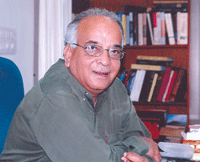 Likewise Dr. Mushirul Hasan, the Cambridge educated vice-chancellor of the Jamia Millia Islamia University in his booklet, Muslims in Secular India: Problems and Prospects in Education (Academy of Third World Studies, Jamia Millia Islamia, 2003), notes that the growth of madarsas has aided rather than hampered the secular education of the Muslim community.
Likewise Dr. Mushirul Hasan, the Cambridge educated vice-chancellor of the Jamia Millia Islamia University in his booklet, Muslims in Secular India: Problems and Prospects in Education (Academy of Third World Studies, Jamia Millia Islamia, 2003), notes that the growth of madarsas has aided rather than hampered the secular education of the Muslim community.
“...madarsas do not necessarily nurture fundamentalists. Part of the reason why they flourish is because the State had not done enough to promote ‘secular’ education in mofussil towns and the rural hinterland... Over the decades such schools have performed a vital function (as did the gurukuls or the Christian schools) and if today they are out of sync, they cannot, for this reason alone, be done away with. They should be treated with sympathy and understanding rather than with suspicion and disdain. Central and state governments should intervene creatively to truly secularise their curriculum and methods of instruction... They can still be the resource of and the inspiration behind rationalist thought and reformist initiatives,” writes Hasan.
Yet if today the country’s 30,000 madarsas are “out of sync” institutions dispensing variable and poor quality secular education to children of the struggling Muslim community, their condition characterised by deplorable infrastructure, obsolete pedagogies, poor quality teachers and abysmal learning outcomes, they are not much worse than India’s 1.24 million government schools. But the learning outcomes of madarsa children are worse because there’s no apex-level agency to promote standardised education. The consequence is that most madarsas are run like family businesses, their operations and financial transactions veiled in secrecy.
Although the number of Muslim children who attend madarsas (the Sachar committee report estimates a mere 3 percent) is small, there’s a pressing need to reform, standardise and modernise their education as most of the clergy and scholars receive their formative education in madarsa schools, and play a major role in developing the religious and secular outlook of the Muslim community. Given their vast reach and geographical spread, the country’s 30,000 madarsas have the potential to catalyse an education renaissance within the Muslim community. Hence the intensifying pressure for the CMB.
Therefore the more liberal elements within the Muslim clergy are beginning to warm to the idea of reform of Muslim education starting with madarsas. Among them is Maulana Saidur Rehman Azmi Nadwi, principal of the Darul Uloom Nadwatul Ulama, Lucknow, one of India’s most respected seminaries, who welcomes the proposal for a madarsa board which would standardise curriculums, result in better pay for teachers and promote inter-faith interaction.
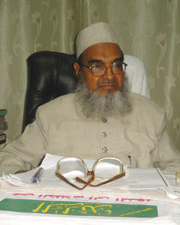 “Reform of madarsa education engineered by the best minds within the Muslim community will enable Islam to be seen for what it is: a religion which accords highest emphasis on creating good human beings and participating, contributing citizens. Education reform in this direction should be welcomed,” says Maulana Nadwi. And to this end, the Maulana is already practising what he preaches. The institute he heads is a shining example of liberal Islamic education. Established in 1894 with the express objective of treading the middle path between religious and secular education, the Darul Uloom Nadwatul Ulama draws its 4,000 students from all over the country, and dispenses IT and English learning besides offering a special condensed course in theology to students who are unfamiliar with Urdu or Arabic, and also publishes Hindi and English periodicals.
“Reform of madarsa education engineered by the best minds within the Muslim community will enable Islam to be seen for what it is: a religion which accords highest emphasis on creating good human beings and participating, contributing citizens. Education reform in this direction should be welcomed,” says Maulana Nadwi. And to this end, the Maulana is already practising what he preaches. The institute he heads is a shining example of liberal Islamic education. Established in 1894 with the express objective of treading the middle path between religious and secular education, the Darul Uloom Nadwatul Ulama draws its 4,000 students from all over the country, and dispenses IT and English learning besides offering a special condensed course in theology to students who are unfamiliar with Urdu or Arabic, and also publishes Hindi and English periodicals.
“Madarsas need to be reinvented to become market-driven institutions which prepare Muslim youth for vocations and the professions. The proposed CMB would do well to model our madarsas on Christian missionary schools and provide both religious and secular education, so that people of all faiths throng to them without prejudice. Muslim ideologists need to shed the legacy of Islamic fundamentalism and confront the issue of the socio-economic disadvantages that our youth suffer because of deprivation of secular education. It’s high time they saw the writing on the wall,” says Fahimuddin, senior fellow at the Lucknow-based Giri Institute of Development Studies (estb. 1973), an autonomous research institute under the umbrella of the Indian Council of Social Science Research.
Meanwhile there’s no shortage of knowledgeable Muslim intellectuals who argue that madarsas were never intended to be purely religious schools. In pre-independence India they were respected for the secular education they provided and attracted non-Muslims including India’s first President Rajendra Prasad, as students. But with the spread of English language ‘missionary’ schools and the establishment of vernacular medium schools by state governments after independence, and the myopic insistence of a large number of madarsas to continue to teach in the Arabic (instead of Urdu or Hindi) medium, marginalised them. Moreover with a substantial number of middle and upper class Muslims migrating to Pakistan after independence and the Abolition of Zamindari Act (UP, 1951) diminishing the wealth of the Muslim landed elite, the patronage they had extended to institutions including madarsas was sharply reduced and most of them gradually transformed into mosque-run schools managed by the clergy.
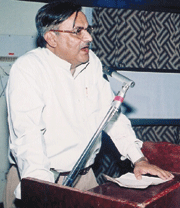 Comments Irfan Ahmad, secretary of the Lucknow-based Pakistan-India People’s Forum (estb. 1994): “With the migration of most well-educated Muslims to Pakistan in 1947, the quality of Muslim leadership in India suffered. Those who stayed back remained aloof from the masses. Gradually leadership passed into the hands of the ulemas and those they patronised. Unfortunately the ulemas were ill-equipped to build a progressive modern Muslim community or engage in meaningful dialogue with the national post-independence leadership. This leadership lacuna has inflicted incalculable harm on Indian Muslims.”
Comments Irfan Ahmad, secretary of the Lucknow-based Pakistan-India People’s Forum (estb. 1994): “With the migration of most well-educated Muslims to Pakistan in 1947, the quality of Muslim leadership in India suffered. Those who stayed back remained aloof from the masses. Gradually leadership passed into the hands of the ulemas and those they patronised. Unfortunately the ulemas were ill-equipped to build a progressive modern Muslim community or engage in meaningful dialogue with the national post-independence leadership. This leadership lacuna has inflicted incalculable harm on Indian Muslims.”
Meanwhile external events including subcontinental geo-politics of the past three decades have played a major role in influencing Muslim minority education in India. In particular the huge flow of American and Saudi Arabian money and weaponry into the Taliban and jihad factories of Afghanistan and Pakistan to end the Soviet occupation of Afghanistan gave a huge boost to Islamic fundamentalism in the subcontinent. Following the successful ouster of the Soviets from Afghanistan in 1989, heavily armed Afghan and Pakistani extremists turned their attention to the long-festering India-Pakistan dispute over Kashmir.
Repeated atrocities in Kashmir which culminated in the brief Kargil conflict (1999) strengthened the hands of the right-wing Hindu BJP and its sangh parivar cohorts (RSS, VHP etc) which engineered the Babri Masjid demolition (1992), the Bombay communal riots (1992-93) and the Islamic extremists’ attack on Parliament in Delhi which precipitated the BJP-engineered Godhra riots in Gujarat (2003).
Unsurprisingly, the troubled history of the subcontinent during the past three decades and the rise of the BJP and sangh parivar outfits as major forces in Indian politics has created a siege mentality within the Muslim community, forcing it to focus upon issues related to protection and perpetuation of the Muslim identity, pushing education to the back burner and prompting madarsas to transform into closed, change-resistant institutions. Moreover the community’s siege mentality was reinforced following the September 11, 2001 attacks on the World Trade Centre in New York by Islamic radicals, after which all Muslim education institutions including madarsas were regarded in the popular imagination as jihad factories.
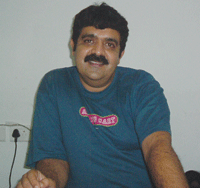 But according to Yoginder Sikand, author of Bastion of the Believers, Madrasas and Islamic Education in India (Penguin, 2005) and a well-known columnist, it’s important to distinguish between madarsas in India and those in Pakistan, Afghanistan and the Middle East. “Militancy has never been nor is a prominent feature of Indian madarsas. In fact it is Hindu nationalists who have been engaging in political militancy. It is a sign of the extremely loaded discourse on nationalism in contemporary India that while madarsas, the vast majority of which have nothing whatsoever to do with militant activism, are routinely described as dens of terror, while schools and organisations run by Hindutva groups are generally regarded as ‘nationalist’, and as defending the honour of the country that is under constant threat from enemies within and without,” says Sikand, an alumnus of London University and Institute for the Study of Islam in the Modern World, Leiden (The Netherlands).
But according to Yoginder Sikand, author of Bastion of the Believers, Madrasas and Islamic Education in India (Penguin, 2005) and a well-known columnist, it’s important to distinguish between madarsas in India and those in Pakistan, Afghanistan and the Middle East. “Militancy has never been nor is a prominent feature of Indian madarsas. In fact it is Hindu nationalists who have been engaging in political militancy. It is a sign of the extremely loaded discourse on nationalism in contemporary India that while madarsas, the vast majority of which have nothing whatsoever to do with militant activism, are routinely described as dens of terror, while schools and organisations run by Hindutva groups are generally regarded as ‘nationalist’, and as defending the honour of the country that is under constant threat from enemies within and without,” says Sikand, an alumnus of London University and Institute for the Study of Islam in the Modern World, Leiden (The Netherlands).
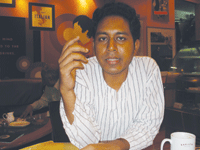 However the crisis of identity has forced even liberal Muslim academics to regard all Muslim education reform initiatives with suspicion. Arshad Amanullah, a 32-year-old filmmaker and researcher with a postgraduate degree in mass communication from Jamia Millia, Delhi in addition to qualifications from the Salafia Madarsa, Varanasi and is currently working on a visual documentary of the Right to Information Act, 2005, is not sure that the required change needs to come from a government sponsored body. “Madarsa graduates enjoy a special status in the Muslim community. Therefore madarsa reforms such as adoption of Hindi as the medium of instruction should come from within the community. In many cases that is already happening. In Varanasi after the 2006 bomb blasts, madarsas voluntarily imposed stringent background checks on students and post 9/11, madarsas and seminaries set up websites and appointed public relations officers. Mere affiliation to a central board will not raise standards of Muslim education. Moreover there’s also a need to focus on the 90 percent or so Muslim children who study outside the madarsa system,” comments Amanullah.
However the crisis of identity has forced even liberal Muslim academics to regard all Muslim education reform initiatives with suspicion. Arshad Amanullah, a 32-year-old filmmaker and researcher with a postgraduate degree in mass communication from Jamia Millia, Delhi in addition to qualifications from the Salafia Madarsa, Varanasi and is currently working on a visual documentary of the Right to Information Act, 2005, is not sure that the required change needs to come from a government sponsored body. “Madarsa graduates enjoy a special status in the Muslim community. Therefore madarsa reforms such as adoption of Hindi as the medium of instruction should come from within the community. In many cases that is already happening. In Varanasi after the 2006 bomb blasts, madarsas voluntarily imposed stringent background checks on students and post 9/11, madarsas and seminaries set up websites and appointed public relations officers. Mere affiliation to a central board will not raise standards of Muslim education. Moreover there’s also a need to focus on the 90 percent or so Muslim children who study outside the madarsa system,” comments Amanullah.
Meanwhile the lamentable socio-economic condition of Muslim youth within the booming Indian economy has prompted several madarsa boards and leaders to suo moto broaden the secular content of their schools. For instance the Jamiat Arabia Ulum ul-Islamia madarsa in Kutch, Gujarat offers a four-year Arabic language course within its seven-year primary regular curriculum course to its 300 students, equipping them to choose between madarsa education or regular schooling later. Likewise the Jamait-ul- Hidaya, Jaipur aims to produce “ulema furnished with language skills in Arabic, English and Urdu, with advanced knowledge of science and mathematics”, and boasts impressive infrastructure comprising engineering workshops and science laboratories.
Even resource poor madarsas are beginning to ensure that the children of the poor who attend them get a fighting chance in the secular world beyond school gates. For instance at a small madarsa run in Chennai’s Porur suburb, Mullah Abdul Karim provides supplementary science and maths tuition to 25 students below the age of 15. “We tutor children outside regular school hours to encourage them to remain in school and get an education. Moreover there are a few full-time residential madarsas which house children from poor families whose parents cannot afford to send them to school. We also help some needy children attend regular school by paying their tuition fees,” says Karim.
Certainly pressure for reform of the madarsa school system and curriculum is intensifying within the educationally short-changed Muslim community countrywide. Ishtiaque Danish, a senior reader at Jamia Hamdard’s department of Islamic Studies, conducted a Unicef sponsored study titled ‘Re-Starting Muslim Dropout Girls in Education’. According to the study, in 2004 in the three Muslim dominated districts of Uttar Pradesh (with 16,000, UP boasts the largest number of madarsas coun-trywide) — Siddharthnagar, Barabanki and Moradabad — 94 percent of parents who sent their children to madarsas wanted the syllabus revised, with a still higher number asking for inclusion of technical or professional education. Moreover 60 percent of madarsa teachers described the syllabus as inadequate. And 79 percent of them were in favour of an All-India Madarsa Board (aka CMB) to prescribe a common syllabus for all madarsas.
Although the great majority of Muslim ulema or clergy fear political interference in madarsa education, Zubair Hudawi, himself a madarsa graduate from Kerala and currently a Ph D student at Delhi’s Jawaharlal Nehru University, believes that political and secular involvement is a necessary condition of reforming madarsa education. “In Kerala the support and active participation of political leaders and some secular-minded people in the running of religious learning centres has made modernisation possible. Such broad community involvement is missing in north India, where the ulemas are deeply divided and cannot think beyond the existing system, while secular, educated Muslims want nothing to do with madarsas. In Kerala, leaders and intellectuals from all walks joined the ulemas to improve and upgrade the religious education system. It’s a good example for the community to follow,” he says.
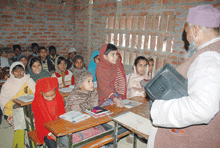 Justice M.S.A. Siddiqui, chairman of NCMEI which has proposed the CMB, takes pains to stress that the objective of the board will be to enrich the secular and vocational content of madarsa education without interference with Quranic education. “The CMB won’t interfere with codes of conduct and other traditions which have a positive bearing on making and strengthening the character of Muslims. We only seek to introduce modern education in addition to whatever they’re already teaching in madarsas across the country. Integrated development and mainstreaming of madarsas is vital as AMU and Jamia Millia, the only two universities that recognise madarsa education, have limited capacity. A central board certifying madarsa education will greatly widen tertiary education opportunities of Muslim youth,” he argues.
Justice M.S.A. Siddiqui, chairman of NCMEI which has proposed the CMB, takes pains to stress that the objective of the board will be to enrich the secular and vocational content of madarsa education without interference with Quranic education. “The CMB won’t interfere with codes of conduct and other traditions which have a positive bearing on making and strengthening the character of Muslims. We only seek to introduce modern education in addition to whatever they’re already teaching in madarsas across the country. Integrated development and mainstreaming of madarsas is vital as AMU and Jamia Millia, the only two universities that recognise madarsa education, have limited capacity. A central board certifying madarsa education will greatly widen tertiary education opportunities of Muslim youth,” he argues.
With the booming Indian economy expanding at 9 percent-plus per year experi-encing an unprecedented shortage of skilled workers and professionals, the country’s hitherto marginalised 150-million strong Muslim community has a great opportunity to contribute to the national development effort by mainstreaming the education of its youth. To this end, ready acceptance and endorsement of the proposed Central Madarsa Board would be a good starting point.
There is no reason why the community which has a lengthy achievements list, from building the country’s most visible calling card (the Taj Mahal) and the first Grand Trunk Road (constructed by Sher Shah Suri in the 16th century) to producing the father of India’s missile technology (former President A.P.J. Abdul Kalam), should not reclaim its former glory. The contradictions within a community torn between religion and modernity can be resolved only if its leaders espouse the cause of liberal, secular education. This will enable the minority Muslim community to play a front-line development role within 21st century India’s rapidly maturing economy. Indeed the country’s future depends upon it.
With Autar Nehru (Delhi); Summiya Yasmeen (Bangalore) & Hemalatha Raghupathi (Chennai)